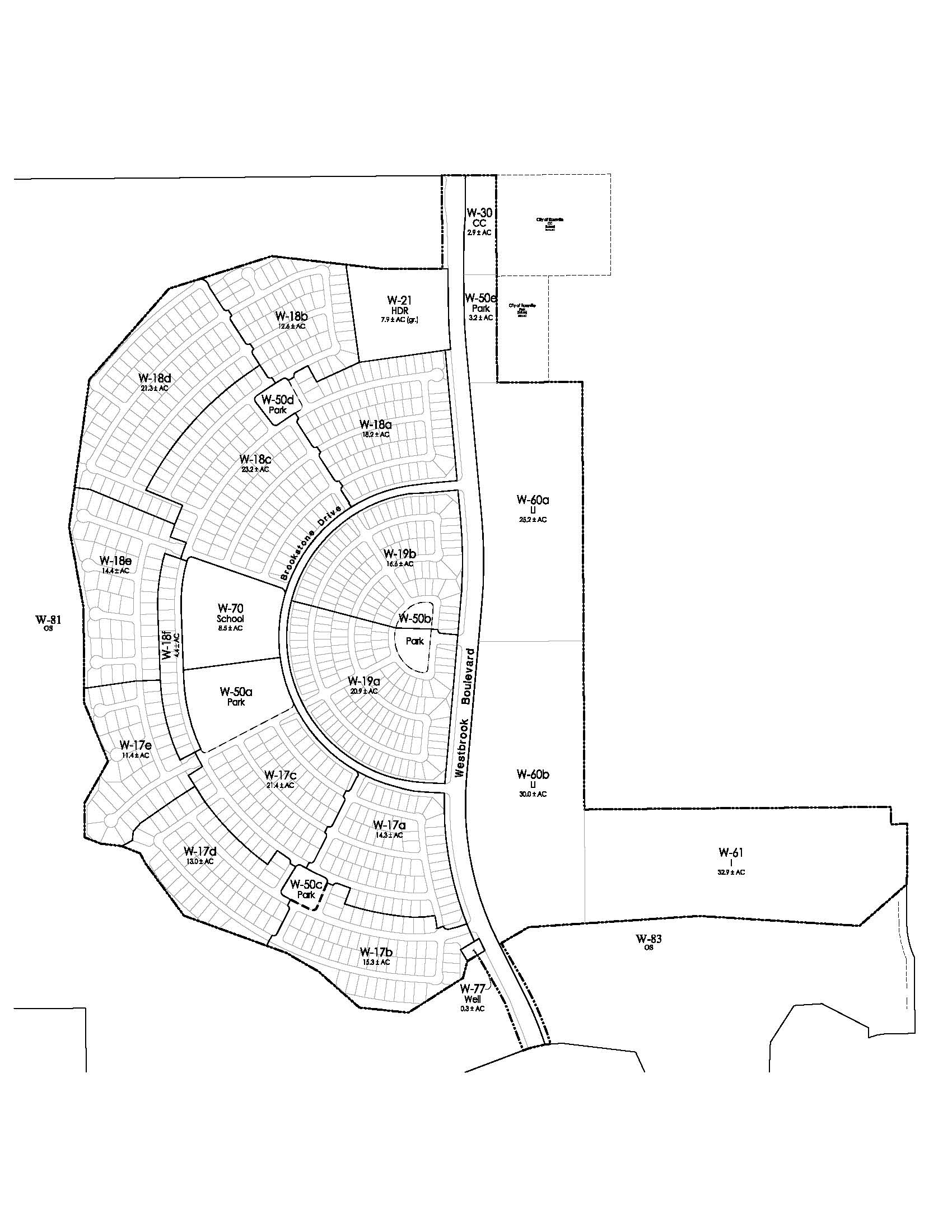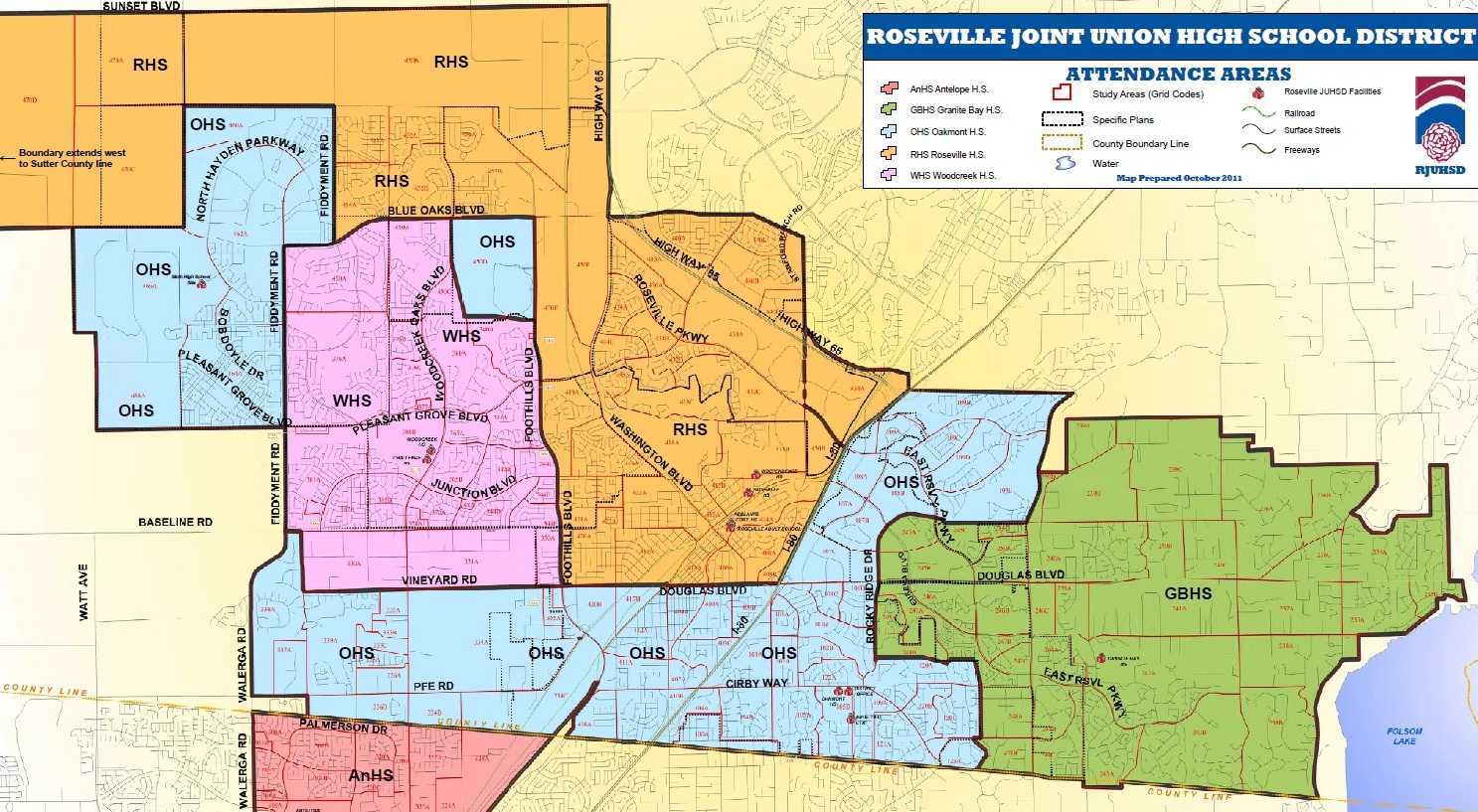Everything posted by scook
-
Meeting with West Roseville Developers September 18, 2013
On September 18, 2013, WFFNA board members Loren and Sue Cook met with Jeff Jones and Ryan O’Keefe of WestPark Communities and received the following updates: WestPark – Fiddyment Updates: WestPark: Phase 3 is under construction, including developments by Meritage and KB Homes, all Low Density Residential (LDR). Phase 4 land has been sold for development by Pulte and Lennar. WestPark Communities has kept the property currently designated for the 4th potential school and light industrial. Fiddyment: Building continues with Lennar and JMC developments on the east side of Fiddyment Road north of Blue Oaks. Still awaiting SEIR on SPA-3 -- will keep you informed! Sierra Vista [area between WestPark and south to Baseline Road] Updates: Westbrook: (south of Pleasant Grove and east of WestPark) Phase 1 has filed for a minor plan amendment: includes a slight reconfiguration of the park (retains same acreage) to accommodate housing plans; adds 10 more LDR and reduces MDR by 21 (overall 11 units less than original allocation)—less density is always a positive now. Phase 2 is in planning stage. Sierra Vista: JMC has submitted a map plan for development of the land portion along Fiddyment Road.
-
WestPark – Plan Amendments for 2013 - Meeting Summary
WestPark – Plan Amendments for 2013 On May 8, 2013, about 22 members of WFFNA attended a presentation from John Tallman of WestPark Associates to give our residents an update on the WestPark area of the West Roseville Specific Plan (WRSP). He touched briefly on updates for surrounding areas, including the O’Brien Kennels. He indicated proposed construction bids were due that day for the W-15 area—construction could begin June 1st and may have homes there by late summer. Phase 3 is expected to start development in the Spring of 2014. And the Denio’s property (736,000 square feet along Baseline (Sierra Vista) is in the design phase (hoping to get large shopping complex). Mr. Tallman then moved into the main purpose for the presentation—to introduce the proposed changes for the Phase 4 area of the WestPark area of the West Roseville Specific Plan. He provided a chart of the area as currently approved, and a chart of the proposed changes. These changes would increase the current count of 780 units to 887 units, but with a decrease in the W-19 High Density Residential (HDR) to 165, the overall effect would be to add 25 more units. Most people seemed happy with the proposed changes overall. The large school park would be reduced with the acreage used to add 3 pocket parks throughout the area. The HDR facility (now W-21) was moved to the northern boundary towards Blue Oaks Avenue; W-19A and W-19B were changed to all low density residential (LDR); Brookstone Drive was expanded (wider than Hayden Blvd.) and no homes will face the street in front of the school. Westbrook Boulevard will eventually be a six-lane road like Fiddyment and Blue Oaks. Other changes include a commercial property change—split to two parcels instead of 1 and rezoned: one to heavy industrial and one to light industrial (which includes yards). Pulte still owns the Village Center property and nothing further has happened on that (probably not until all the surrounding homes under way now are completed). Once again, the subject of the still missing high school was raised. Mr. Tallman said $7,500 per rooftop is taken from each permit pulled, and other taxes are collected towards the high school as well. The high school district has purchased the land, but last word still has the high school not expected to open until 2018. The proposed Phase 4 Plan Amendment was filed in February and is in process—probably first to Parks and Recreation Commission on June 4th, and Planning Commission the second Tuesday in July, and finally to the City Council either July 17th or July 31st.
-
Summary of SPA3 Presentation
On March 10, 2013, at the WestPark-Fiddyment Farm Neighborhood Association (WFFNA) Board Meeting, Steve Hicks and John Bayless, representatives for the Fiddyment Farm developers, gave a very good slide presentation followed by an extensive Q&A period that lasted almost 90 minutes. The slide presentation gave the following updates on development: Fiddyment Farm School (built jointly by WestPark and Fiddyment Farm developers) will open this August. Two more groups of single family homes in the F-15 and F-16 areas have started construction. Lennar has started a group of 86 lots up in the F-14 area. He reviewed the numerous amenities of Fiddyment Farm: Median islands which help slow traffic into the neighborhoods Beautiful tree lined parking strips in front of homes Streets running adjacent to open spaces and parks Pocket parks unique to Fiddyment Farm (8 eventually), and 4 Neighborhood Parks 5 miles of bike trails plus hiking trails through the parks Mr. Hicks indicated the second school of the area opening in August, another 2 elementary schools in the West Roseville Specific Plan as needed. He also indicated our students are currently attending Oakmont High across town, but the high school property was purchased in May 2011. Unfortunately, the opening of the high school has now been postponed until 2018. Mr. Hicks said Fiddyment Farm is in the 9th year of a 20-year build-out schedule. The partial extension of Blue Oaks to Hayden Parkway was advanced from Phase 4 to coincide with the completion of the new Fire Station #9 due to open soon. Then Mr. Hicks got into the details of requested amendments proposed in SPA-3, indicating the proposed number of homes to be modified: Adds 586 LDR (Low density residential) units, less 98 acres (transferred to other uses)—creating new average density of 4.9 units per acre. [Examples of properties—Silver Oaks at 2.4 to Sonata at 4.1 units per acre, and Shadow Creek 4.8 to Bella Terra at 5.5 units per acre.] Adds 609 units of new MDR (mid density residential) at average 10.9 units per acre. [Examples Pleasant Creek at 8.0 to Villemont (near Costco) at 9.5 units per acre.] Adds 472 units of HDR (high density residential) at 25 units per acre (in two additional projects in Phase 3 near F-71 school property. [Examples Vintage Square and Siena Apts. at 22 units per acre.] 3 HDR units off Fiddyment Road in Phase 1 area will maintain build out at 20 units per acre (with City agreement). Total additional housing: said to be 1,661 units in City Summary, however figures add up to 1667. Adds 2 commercial properties at F-6 area and F-81 at Angus Rd. and Fiddyment Road. Mr. Hicks said the added density would bring school population from 3.2 to 4.0 to guarantee the fourth school. A Subsequent EIR is in preparation now and should be available this summer. It will include all new approved developments since the initial 2004 EIR. Following the presentation, Steve Hicks and John Bayless responded to questions and concerns from the audience; examples as follows: A concern was raised about traffic to the new Fiddyment Farm school and when Hayden Parkway would open. Phase 2 and 3 are expected to take 10 more years to build out. Hayden Bridge will not be completed until Phase 3, probably 4 or 5 more years, so traffic will have to route through the local neighborhood streets. But there is a close access to the school now. Why were the two additional HDR facilities added? They were added to accommodate city needs to meet low income housing requirements. At build-out, our HDR level will be 27% of the West Roseville Specific Plan. Other concerns were stated regarding the projected increase of density, including increased crime. The developers indicated that they are building to meet market driven needs. They also said increased density could have benefits of getting our amenities quicker, and guaranteeing the fourth elementary school. Mayor Susan Rohan indicated full consideration would be given to reviewing the SEIR, and urged residents to submit their comments, letters and questions to the City Planning Department. Steve Hicks agreed to come back for another meeting to share thoughts after the Subsequent EIR comes out and he will contact Loren Cook at that time. Steve Hicks: (916) 240-2752 John Bayless: (916) 275-1885
-
Roseville Energy Park – Proposed Liquid Management System
Roseville Electric gave a presentation of their proposed Liquid Management System (LMS) to the Roseville Coalition of Neighborhood Associations at the March 21, 2013, RCONA Board Meeting held at Martha Riley Center at Mahany Park. Approximately 35 board members and interested residents attended. Matt Garner, Interim Power Generation Superintendent, gave a 55 minute presentation for the proposed Liquid Management System. This system would replace the current process for disposal of waste water from the Roseville Energy Plant. Matt’s slide show was followed by a question and answer period addressing the numerous concerns raised by the RCONA members and various residents attending the meeting. The Power Plant generates up to 160 megawatts of electricity; it supplies 40-50% of the city’s power needs in summer, and all the power needs of the City in cooler times. The process of producing electricity uses a steam turbine cycle which requires water to cool it. The current process including discharge of the waste water produced costs $2 million to operate and maintain. The proposed LMS would cost $5.9 million to implement and reduce disposal costs to $200,000 per year, representing a great savings to the City. Mr. Garner assured audience members that the system would meet all regulatory requirements and be closely reviewed by both the federal EPA and California Energy Commission. The application Roseville Electric submitted to the state in February has already been accepted as ‘administratively complete’. Actual technical review is now underway. Public meetings will be held with representatives of state agencies as the application proceeds. Mr. Garner said any new system must meet four criteria, to Be technically feasible—a proven sound technology Be financially prudent Meet regulatory requirements Protect natural resources around the plant (including drinking water, streams, etc.) Mr. Garner said although they looked at other alternatives, they found the LMS injection well process best fit all the criteria. If the LMS is approved by all environmental agencies and City Council, the current zero liquid discharge system will still remain in effect as a back-up system for the first two years of the new system. Actual design details of the proposed Liquid Management system can be viewed at a Roseville Electric site (link included with others below). Mr. Garner indicated they’d had a number of concerns already raised by residents and gave his responses to the most common ones: Would there be any long term effects or contamination into the aquifer? Because of the multiple layers of protection built into the system, and because this is not an earthquake prone region, the chance of possible contamination was extremely small. The equipment will be monitored 24/7 and meet all environmental requirements. What is the effect on the salt-water sub-level where the waste water is going to be pumped? Their geologist said what they will be pumping is an extremely small amount of water, like rain-water on an ocean, so it would be minimal. [Comment: a previous meeting disclosed the amount of waste water involved is 13,500 gallons per hour with roughly 10-20 tons weekly of minerals and waste products, running at 40% capacity of the City’s full needs.] Will this process involve ‘fracking’? Mr. Garner said the process is definitely not ‘fracking’. [Comment: numerous geological reports do refer to the underground injecting of waste water as a type of ‘fracking’ now being linked to earthquakes. See links to articles below.] What are the guidelines to ensure no earth resources are harmed? EPA requires annual testing for integrity of the system and complete 5- year test (including x-ray tests) for integrity; 24/7 monitoring; test fluids being submitted on regular basis; 2 test wells along-side of the injection wells for fluid sample tests to ensure no migration of fluids being put underground. When the system works at full capacity, what will the effects be as the City grows? The Energy Plant runs 40% of the time as and will not exceed that rate, even as the City grows. Currently, they are in the permit application process, including design and final permits for construction, and then apply for City Council approval, and final procurement. Construction, certification and final testing will take 6-9 months. After a final wrap-up of items, Mr. Garner took questions from the audience: Where is the system being used and how long has it been in use? This type of system has been used since the early 80’s; Lodi just started using a similar system last year. Mr. Garner said it’s a Class 1-non-hazardous injection well. What is current system? All the waste water is currently recycled back into the system; 10-20 tons of salt minerals every week are removed and go to land fill. LMS--High mineral content water will be injected underground into a contained space. What possible relation is the LMS to seismic activities? Michele Santangelo, an engineer on the project, indicated other sites have had issues, the soil didn’t substantiate it. However, they have done seismic studies within a 3- mile area around the project as required by the EPA; the closest fault line is actually 13 miles to the West, so she believes it is safe. They did admit the ground pressure would increase, and the EPA will be interested in the safety of that increased pressure. If there was a catastrophic incident in the system, would the aquifer water be contaminated? It was felt that even if an accident occurred, all the safety measures in place in the system would prevent any further contamination—our drinking water would still be safe. What testing methods will there be? In addition to the two injection wells, there will be two test wells (going to the aquifer level only) to monitor the quality of the aquifer level. They had no figures to provide of past accidents at other plants, but said anything humans touched could have adverse effects, and that’s why so many safe guards would be in effect, and they have to maintain funds just in case of incidences. What chemicals would be in the waste water? They said the EPA will say what can and can’t be included in the water allowed underground, including PH balancing chemicals. What information is available about failure of these systems? Mr. Garner said the EPA doesn’t have 5- or 10-year information, but they will require all safety measures to protect the aquifer -- that’s the key. Can you provide any information about the water pressure build up? The pressure hasn’t been determined yet until they do core tests. However, 225 gallons per minute are expected to be pumped underground (approximately 8 swimming pools a day), but it is a small amount for the size of the underground area. What other alternatives have been looked at? Pre-filtration was already installed; several types of evaporation and treatment ponds; cold-lime softening processes; 10 to 15 options were looked at. Over half of them had a fatal flaw or increased costs—the LMS was the only one that met all four criteria. The current liquid disposal method would stay in place for 1-2 years as back-up. Will the ASR wells for the (aquifer) have increased testing? Sean Bigley from Roseville Environmental Utilities said there are monitoring cells in their system, but they will get further information out as it will relate to the LMS and ensuring the safety of the aquifer. What will be the long range effects from natural electrolysis (salt damage, etc.) in the system? The minerals are already under pressure, and precipitation will be miniscule. Materials will be designed not to corrode. How long is the solution supposed to last? The life expectancy of the power plant itself is 20-25 years, and the LMS is expected to last as long as the plant. We’ve had reports of excess settling in homes and earthquakes due to prolonged water pressure building up—can we be reassured against this happening? You can’t compress water, but this is such a large area, the amount being injected should not cause problems. What is meant by ‘mineral enriched’ that will be in the water being injected and deterioration of the equipment? Will there be gaps underground to allow for the added waste water? Again, the EPA will require monitoring of chemicals, maintenance of equipment, and maximum pressure allowed. Roseville Electric will have a display at the Earth Day event April 20, 2013, at Mahany Park. Questions can be sent to Matt Garner at (916) 746-1699, or emailed to liquidmanagementsystem@roseville.ca.us. The following links have been added for you to obtain further information: Roseville Electric’s project overview of the Liquid Management System: www.roseville.ca.us/lms EPA Guidelines: http://water.epa.gov...ctric/index.cfm http://www.epa.gov/r5water/uic/faq.htm Definition & types of ‘fracturing’: Hydraulic fracturing – Wikipedia http://en.wikipedia....aulicfracturing Food& waterwatch – Ban Fracking in California June 2012: www.foodandwaterwatch.org/factsheet/ban-fracking-in-california News articles re geological findings related to ‘fracking’: www.ldeo.columbia.edu/news-events/wastewater-injection-spurred-biggest-earthquake-yet-says-study www.businessinsider.com/fracking-wastewater-oklahoma-earthquake-2013-3 www.propublica.org/series/injection-wells www.propublica.org/article/injection-wells-the-poison-beneath-us www.propublica.org/article/epa-finds-fracking-compound-in-wyoming-aquifer
-
School News Updates
Chilton Middle School Dedication The Barbara Chilton Middle School finally opened for our WestPark and Fiddyment Farm students on August 21st, 2012, and the dedication ceremony was held August 28th. It was a standing room only crowd in the multi-purpose room, including the students themselves who had been invited to attend. The audience was treated to intro tunes from the Chilton “Bobcats” Band, followed by a rousing performance of the Star Spangled Banner by young student Sophia Leekley. The Bobcats cheerleaders also led a quick opening cheer to support their school. Principal Jeff Ancker gave brief introductions of the Roseville City School District board members present, then Council member Carol Garcia (Barbara Chilton’s daughter) introduced other members of her family and friends who spoke of the great dedication of Dr.Barbara Chilton and how proud she would have been of the school named in her honor. Throughout the ceremony, there was a great reflection of pride in the new school by the students, faculty and attending parents. The ceremony program and pictures have been put on our WFFNA Schools site. We have also provided a link to the Press Tribune’s article on the school opening. More WFFNA photos can be found in the Gallery here Download the Dedication Program below: Barbara Chilton Middle School Dedication August 28, 2012.pdf High School Update On a less happy note, WFFNA members Loren and Sue Cook met with Roseville Joint Union High School District Superintendent Tony Monetti, school board member Scott Huber and Assistant Superintendent Gary Stevens on August 8, 2012. They provided a project review and explained that the land was already purchased, and plans for a campus to accommodate 2,400 students were 73% completed, but would include phase-in changes as needed. Over $12 million has already been expended on the purchase of the land and development plans. Total project expenditures have gone from an estimate of $216 million in 2007 to just under $58 million for 2018, which is the latest expected completion date now reflected, following a two-year construction period. They will seek additional state funding in 2014. While the projected budget has been greatly reduced for the new school, Mr. Monett said it would be a campus to be proud of, with an “emphasis on learners,” including expandable walls to accommodate changing class sizes. They hope to incorporate special engineering programs for students in connection with the power and water treatment plants in this area. Once again, we expressed our hope that the high school, originally slated to open in 2013, could be completed as soon as possible. Again, there are no plans to address redistricting until the new school is ready to open.
-
WFFNA Easter Egg Hunt
WFFNA is pleased to present our 2nd Annual Community Easter Egg Hunt event, help with funding provided by RCONA (the Roseville Coalition of Neighborhood Associations). Please send an email to Activities@WFFNA.org to sign up your children (only direct relatives - children and grandchildren) please. Indicate number of children by age (preschool or K-2). Also we need help with the event, so please let us know if you can assist with advance prep or activities at the event. In addition to the actual Easter Egg Hunt, and depending on the number of sign-ups, we are planning on at least one Easter egg relay game, coloring Easter bags, mini-cupcakes, and prizes. Please join us in making this a fun experience for the children. When: Saturday, April 7, 2012 at 2:00 - 3:30 PM Where: Festersen Park (behind Junction Elementary School) 2150 Village Green Drive Download flyer: Easter Egg Hunt 2012.pdf
-
High School Updates from Blue Oaks NA Meeting
On Wednesday, February 22, 2012, about 75 members attended a meeting of the Blue Oaks Neighborhood Association. BONA President David Larson had invited Roseville Joint Unified High School District (RJUHSD) Board members to discuss the high school status in the West Roseville area. RJUHSD officials attending included Steve Williams, Scott Huber, and Ron Sieverson. BONA members expressed their concerns over the school district boundaries and having children bussed to Roseville High School when Woodcreek High School is closer. School board members responded that boundaries were redrawn eight years ago when Antelope High School opened. All of the high schools are now full except Oakmont High School (where our WestPark – Fiddyment Farm students are now bussed). Parents told of the difficulties having students from Cooley Middle School sent to three high schools, splitting up friendships at a sensitive time in teenagers’ lives. The school board responded it receives over 1,600 transfer requests each year, but the transfers must be based on legitimate educational reasons, not separated friends. If a transfer is granted, it does not guarantee that the student will end up in a closer school. Assistant Superintendent Ron Silverson said the new high school to be built in the West Roseville Specific Plan, originally projected to open in 2013, is not expected to open now until 2017, based on the declining housing sales and economic downturn. They don’t expect to address changing boundaries until closer to the new high school’s opening.
-
Placer Food Bank Tour
On Tuesday, January 24, 2012, members from the Roseville Coalition of Neighborhood Associations (RCONA) were provided a tour of the Placer Food Bank hosted by Food Bank officials Troy Kuhn, Alan Osterstock, and Mary Towne. This visit was part of RCONA President Werner Kuehn’s vision to partner with various Roseville agencies to expand RCONA’s benefits to the Roseville community. Other RCONA Board members attending the tour were Sue Hallahan-Cook, Lori Ennis, and David Larson, along with Jamie Carlson of the City of Rosevile’s Public Affairs and Communications Department. Our visiting team was provided great background about the extent of the area the Food Bank covers through Placer, El Dorado, and Nevada Counties. Last year, the Food Bank supplied approximately 5.7 million pounds of food among 40 to 50 local certified non-profit agencies; those agencies then serve an average 48,000 qualified individuals a month. Placer Food Bank is a fully accredited member of the national Feeding America Program, and must meet all the necessary criteria required. One thing that impressed our tour team was how well their system works to stretch their resources. While they do receive food donations through various individuals and corporate sponsors like Wal-Mart and local farm groups, and grants. They really make the most of cash donations received -- each $1 cash donation can buy $10 worth of food, plus they can take advantage to partner with groups at special rates, such as the Blue Oaks Neighborhood Association which contributed hundreds of turkeys this past holiday season for $5 each. Our group was taken through the facility to see samples of boxes packed and ready for pick-up or delivery to various local agencies. The Food Bank operates with a small full-time staff, and greatly appreciates its volunteer staff who help with receiving, sorting, packing and loading this incredible amount of food. One program the Food Bank is especially proud to participate in is the Backpack Program, which works with schools to provide qualified children with food for weekends. RCONA members were very impressed with the Food Bank operations, and discussed various ways we might partner with the Food Bank in the future -- spread the word within our neighborhoods for those who wish to help as volunteers at the warehouse and events, donation sources, ‘backyard gleaning’ (individual food donations,) and future Community Garden efforts RCONA has been working toward, perhaps even recycling as compost. If you can offer services or donations, or know of those in need of Food Bank services, you may contact them at (916) 783-0481 during regular business hours 6:00 a.m. to 2:30 p.m. (see their website at Placer Food Bank.org.)
-
School District Delays Chilton School Opening - Meeting Summary
On Thursday, February 3, 2011, more than a dozen of our WestPark-Fiddyment Farm neighbors attended the Roseville City School District board meeting. On the agenda was the update on the projected opening date for Barbara Chilton Middle School. This matter was placed on the agenda after concerned residents questioned the January 28th notification that the lease agreement to St. John’s School for the use of Chilton for another year. Richard Pierucci, Superintendent, started off by reminding the audience that both Junction and Chilton schools were built by the developers for WestPark and Fiddyment Farms, not by the school district. The developers would be responsible for maintenance of the facilities until the school opened, when the school district would then take over. When the school was completed, the school district determined there were not enough projected students to open the school. In 2008, St. John’s Church authorities approached the school district about using the Chilton facilities while their new church and school were being built; St. John’s would therefore be responsible for costs of maintenance and utilities, and the campus would not be sitting derelict. This latest agreement was seen as a benefit to all the parties at that time, and St. John’s paid $50,000 for 2010/11 and now $120,000 for 2011/12. The new lease will extend the opening of Chilton to August 2012. The Chilton campus issue followed a presentation of the state’s projected shortfall between $11-17 million, depending on a possible ballot measure to extend current fees that would end in 2011. Mr. Pierucci indicated that although teacher costs were not involved in the opening of a campus (teachers follow the students), costs would include staffing (principal, secretary, 2 custodians, library/media specialists, noon-duty personnel, library books, PE and science equipment), totaling approximately $300,000 a year. Mr. Pierucci said these costs used to be offset by lottery money, but with the economic slump, those funds have been ‘swept’ for other uses. However, he stated the rent from St. John’s have been used to off-set the school’s costs. He stated the decision to not open Chilton was not a cost issue, but rather one based on lack of students. They require 300 student occupancy to open a campus and, based on their figures from Junction Elementary and Cooley Middle School, they do not feel they will have enough to open Chilton this year. A number of our residents made statements to the school board stating their concerns and frustration with the school district’s decision. Ryan Pinney felt the projected student figures were lower than the population might indicate; and that he would like to see the 8th grade included when the school would open in 2012. Mr. Pierucci said their figures were fairly close in their last year’s figures—only 20-30 students low, and if there was a strong interest shown by the neighborhood to have 8th grade included, they would be open to consider it. Aaron Herman and Guy Burghgraef questioned the mello roos assessments residents pay for the school services not being provided. While Mr. Pierucci responded that the school district received no mello roos fees from the City, he later stated they do share in some of the funds for the common/public areas. Aaron also expressed his concerns that 5th graders were too young to be included in the middle school. Several speakers expressed their concerns that the lease extension was done without prior notice to the residents after Mr. Pierucci had previously stated he would give advance notice for public comment of any further delays opening Chilton. Sue Cook asked about Mr. Pierucci’s previous suggestion of sharing the Chilton campus with St. John’s school; Mr. Pierucci said they would not share the campus, and St. John’s enrollment had increased so that they now use the full campus. A key topic was the transportation fees that the WestPark-Fiddyment Farm residents must pay for having their children bussed to Cooley , and that there is only one pick-up spot, located at Junction Elementary and students must be taken there first. Mr. Pierucci directed school district staff to research the transportation issues and placed the matter for response on the February 17th agenda. Mr. Pierucci also mentioned that the next elementary school (F-70) north of Blue Oaks was tentatively scheduled to begin construction in spring of 2012 and open in August of 2013. They would be reappraising the school districts to divide enrollment prior to that. Mr. Pierucci will provide the slide presentation for access through the WFFNA website for your review. Next School District Board Meeting: Thursday, February 17, 2011 @ 6:00 p.m. at the District Office 1050 Main Street, Roseville, CA. Submitted by Sue Cook Superintendent Pierucci's Presentation can be downloaded below:
-
SPA 3 Meeting with Signature Properties and City of Roseville Planners
On July 28, 2010, members of WFFNA (Loren and Sue Cook, Rich Fabbre, Ted Daus, and Amy Aufdemberge) met with Steve Hicks of Signature Properties and Mike Isom and Tricia Stewart from the City of Roseville Planning Department to discuss the Specific Plan Amendment known as SPA 3 submitted for the Fiddyment Farm Development. This amendment would add 1905 more units on the north side of Blue Oaks, including more than 700 more High Density Residential (HDR) units. Our representatives expressed its concerns and opposition over the proposed SPA 3 as it is currently submitted. While we understood possible modifications to coincide with the downturn in the economy in recent years, we raised our concerns over the impact a nearly 50% increase in the number of residences from the original West Roseville Specific plan for the Fiddyment Farm area. We expressed our concern that an increase of this order of magnitude will fundamentally change the nature of the neighborhood that we chose to live in. We also stated concerns over the various environmental impact issues of increased traffic, school overcrowding, water shortages and impact on air quality. We were assured by the City that a new environmental impact report (EIR), currently in process, will examine all these issues and more. Our WFFNA members openly expressed their concerns that the City of Roseville is trying to take the easiest way to meet its state mandated SACOG (Sacramento Area Council of Governments) needs for affordable multiple housing units by placing them all in the West Roseville area where there is already current construction going on. Our representatives expressed their beliefs that continued amendments to dump large amounts of HDR units in this area are not consistent with the original West Roseville Specific Plan, but rather represents a large scale “bait and switch” to the homeowners who bought their homes under the original Specific Plan and neighborhood it represented. Mike Isom stated the City would like to work in cooperation with our neighborhood’s citizens and would be willing to hold further meetings to discuss other possible alternatives. Rich Fabbre made a suggestion that the City might be able to fund an in-depth, independent survey of possible sites throughout Roseville where some of the proposed high density units could be built, areas more conducive to the city’s services than found in the West Roseville area. Mr. Isom indicated the City was not prepared to give a blanket approval of SPA 3 and that the City continues to look for other areas. Read more for other issues that were also discussed at this meeting... Other topics discussed with Steve Hicks were: Siena Apartments -- inadequate parking continues to be a problem. Mr. Hicks said the previous resolution for the parking problem fell apart and they are still looking for a solution. Fire Department -- is in the design phase. To coincide with the Fire Department’s needs for access, Signature Properties will advance the Blue Oaks bridge construction up to next year. Construction on the southern bridge (3 lanes) will start in spring of 2011 and allow one-lane traffic in each direction west of Fiddyment to Hayden Parkway. The northern 3 lanes of the bridge will follow as home sales and traffic requirements warrant. The Blue Oaks-Hayden Parkway corner has already been fitted with signal light equipment. Schools -- St. John’s has continued use of Chilton for this next school term only. Further plans have discussed the opening of Chilton in part for use for expansion of Junction Elementary—[possibly using half the facility for 4th, 5th and 6th grades. Steve Hicks assured us that even with the proposed SPA 3 expansion, when the other elementary schools were built, they would still be within the student quota limits. The high school is still looking at possible construction activity by 2011. Parks -- the 2nd Fiddyment Farm park near Corin Drive may start construction in early 2011. SPA 3 proposal would still provide a large number of pocket parks, but the overall sizes of the parks would be slightly reduced. Bike Trails -- Signature is working to connect with the Crocker Ranch bike trails. The economic downturn in sales has delayed the $635 per house bike trail fee and money needed to construct the bridge underneath Fiddyment Road to enable the connection of trails. SPCA -- one of the proposed properties out near the recycling containers would be for an animal shelter. Submitted by Sue Cook






